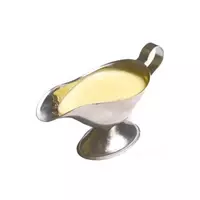Dutch sauce

Dutch sauce or otherwise sauce hollandaise is one of the five sauces commonly considered to be staples in fine French cuisine. And this is even despite the fact that the Dutch sauce is not from this country at all.
It is noteworthy that previously the Dutch sauce was called Isingy, which is associated with the name of the town in Normandy. That is where most of the dairy products came from, especially butter, which is the basis of this sauce. During the First World War, the production of oil in France fell sharply, so they began to import it from Holland - that's why the sauce got its name. At the end of the war, France began to independently produce enough butter, but since then the name of the sauce has remained unchanged.
Dutch sauce or hollandaise is a rather thick sauce with acid, made from butter and egg yolks. Despite the fact that many recipes for Dutch sauce are known today, its composition remains unchanged, only additives change. Shallots are often used as the latter, as well as white, black or cayenne peppers, giving the finished sauce a spiciness. Some Dutch sauce recipes provide for the addition of cream at the end of cooking, which somewhat changes the taste and color of the finished sauce.
However, the main components of Dutch sauce are butter, egg yolks and vinegar, so sometimes it is called butter. By combining these ingredients, the result is a beautiful, thick emulsion that feels a bit like warm mayonnaise. However, unlike mayonnaise, this sauce is prepared not from vegetable, but from butter.
Classic French cuisine has numerous uses of Dutch sauce, but most often it is customary to serve it as an excellent additive to fish or asparagus dishes. Also, it's hard to imagine the famous Benedict eggs without this thick, creamy sauce that perfectly shades the taste of this simple enough meal.
In fact, the preparation of Dutch sauce requires some skills and skills, since only if all conditions are met, a product sufficient in both density and consistency uniformity is obtained. When lemon juice and a number of spices are added, it has a moderate aroma.
It is recommended to serve Dutch sauce to dishes by all means warm, but not hot in any way - this is due to the importance of temperature both during cooking and serving. The fact is that at low temperatures, the Dutch sauce will become lumpy, while at too high the yolks roll up.
By the way, the excess of the finished sauce can be easily frozen, and if necessary, simply leave it at room temperature and warm up a little before serving.
Dutch sauce 432.8 kCal
Energy value of Dutch sauce (Ratio of proteins, fats, carbohydrates - ju):
Proteins: 5.6 g (~ 22 kCal)
Fats: 44.9 g (~ 404 kCal)
Carbohydrates: 1.6 g (~ 6 kCal)
Energy ratio (bj | y): 5% | 93% | 1%
 Español
Español Français
Français Português
Português Русский
Русский 简体中文
简体中文 繁體中文
繁體中文 日本語
日本語 한국어
한국어 العربية
العربية Türkçe
Türkçe Қазақ
Қазақ Deutsch
Deutsch Italiano
Italiano Українська
Українська
